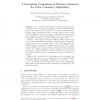Free Online Productivity Tools
i2Speak
i2Symbol
i2OCR
iTex2Img
iWeb2Print
iWeb2Shot
i2Type
iPdf2Split
iPdf2Merge
i2Bopomofo
i2Arabic
i2Style
i2Image
i2PDF
iLatex2Rtf
Sci2ools
ECCV
2008
Springer
2008
Springer
A Perceptual Comparison of Distance Measures for Color Constancy Algorithms
Abstract. Color constancy is the ability to measure image features independent of the color of the scene illuminant and is an important topic in color and computer vision. As many color constancy algorithms exist, different distance measures are used to compute their accuracy. In general, these distances measures are based on mathematical principles such as the angular error and Euclidean distance. However, it is unknown to what extent these distance measures correlate to human vision. Therefore, in this paper, a taxonomy of different distance measures for color constancy algorithms is presented. The main goal is to analyze the correlation between the observed quality of the output images and the different distance measures for illuminant estimates. The output images are the resulting color corrected images using the illuminant estimates of the color constancy algorithms, and the quality of these images is determined by human observers. Distance measures are analyzed how they mimic dif...
Color Constancy Algorithms | Color Corrected Images | Computer Vision | Distances Measures | ECCV 2008 | Illuminant Estimates | Perceptual Euclidean Distance |
| Added | 15 Oct 2009 |
| Updated | 15 Oct 2009 |
| Type | Conference |
| Year | 2008 |
| Where | ECCV |
| Authors | Arjan Gijsenij, Theo Gevers, Marcel P. Lucassen |
Comments (0)

